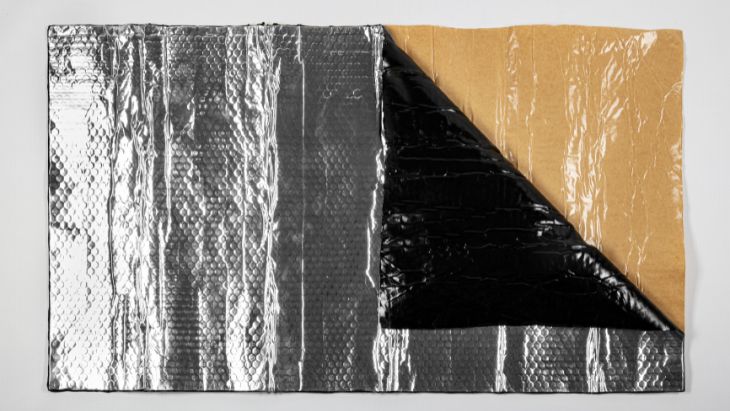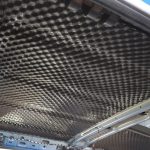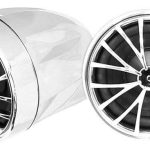Did you know exposure to greater noise levels is fatiguing? The screeching of your tires, the wind noise, or engine sounds when driving can be overwhelming.
For instance, driving a petrol-powered car or any smaller SUV, you’ve noticed the noise it makes while cruising. The noise range of most small vehicles is 70 to 75 decibels.
So, it’s best to cancel it out to enjoy your ride. And what other way than to use a sound deadener?
But what’s sound deadening, and your understanding of a 50 mil vs. 80 mil sound deadener? Read on. You’re about to find out.
What is Sound Deadening?
Sound deadening involves adding an insulation layer between the inside of your car and the outside air. It makes it harder for outside noises to break through cracks and crevices.
If your car has too much noise coming in, then it cannot be easy to hear what people say when they call out to you or knock on your window. Sound deadening materials reduce the amount of sound that comes through your vehicle, making it easier to hear things around you.
It works by adding a layer of foam or fiberglass between interior walls and outside surfaces so that external sources can pass through your vehicle.
The best way to counter sound is through insulation.
Benefits of Sound Deadening
Sound deadening is essential. Here are some reasons:
Noise Reduction
Noise is a nuisance. If you like driving long distances, you know the need to have good quality music, not noise.
Moreover, sound deadening comes in handy if you have the windows down or want to enjoy the fresh air while driving. It will nullify road noise or sound from your engine.
Soundproofing is an answer to less road noise, fewer distractions, and less risk of accidents caused by drivers who aren’t paying attention to their surroundings. Besides, you can have healthy conversations without shouting.
Improved comfort
When you spend extended amounts of time sitting in your car, it is easy to get a little stiff. Soundproofing will help prevent this from happening.
Because sound waves travel slower, they have a lower frequency, meaning they don’t cause vibrations. As a result, soundproofing prevents these low-frequency sounds from reaching your body and causing discomfort. This way, fatigue is canceled out.
Exquisite look and feel
Do you wish to make your car look more than it costs? Adding the sound-deadening materials makes it feel more firm. Everything feels close-fitting, quieter, and warmer. The lighter metallic impression and sound are lost.
80 Mil vs. 50 Mil Sound Deadening Materials
While soundproofing is an answer to noise cancellation, it will only serve you best when done right. Therefore, you need quality soundproofing materials to achieve this. Various materials are available, but the recommended ones are the 80 Mil and 50 Mil. Though the 80 Mil material provides better performance due to its thickness, everyone has their preference.
But first, what is a mil?
A Mil is a unit of measurement of the width of sound deadening materials.
80 Mil means the material has a thickness of 80. Various brands, including Kilmat, Noico, and Dynamat, manufacture materials of this breadth. It is commonly used on the interior and exterior of vehicles because it provides excellent soundproofing properties.
On the other hand, the 50 Mil sound deadeners have thirty Mils less thickness than the 80 Mil. Well, that’s the only significant difference—thickness.
Pros and Cons of 50 Mil Vs. 80 Mil Sound Deadener
Now, with the variance in breadth, there are several pros and cons. So, are you looking for a high-quality sound-deadening material or anything simple to quiet your car? One of the most popular sound-deadening materials is Kilmat 50 and 80.
Pros of 50 Mil Materials
- A 50 Mil material is better since it is easy to fix.
- It is cheap—if you want to lower the noise level in your vehicle without spending a lot of money, then 50 Mil sound deadening is probably a better choice for you.
- It is the best solution for a simple sound-deadening fix.
Cons of 50 Mil Materials
- It doesn’t cancel out all the noise
- It is a lightweight material.
- 50 Mils are not the best materials for complete premium car audio systems.
Pros of 80 Mil Materials
- This material will help reduce noise in your vehicle while still keeping it comfortable to drive daily.
- It is commonly used on the interior and exterior of vehicles.
- It is durable with a perfect finish.
Cons of 80 Mil Materials
- Installing 80 Mil sound deadening on top of your vehicle will add a lot of weight to your car and affect its aerodynamics.
- 80 Mil material is expensive to purchase.
- With weight comes the complexity of fixing; 80 Mil is harder to cut out and fix.
Kilmat 50 Vs. 80 Sound Deadening Materials
As mentioned, soundproofing materials are myriad—from the pricey to the less expensive.
Kilmat 80 is a high-density material that is commonly used for soundproofing applications. Conversely, Kilmat 50 is a low-density material with similar performance characteristics. Both materials offer excellent sound reduction capabilities. However, they have different physical properties and cost significantly less than kilmat 100.
Most customers prefer kilmat materials. The products are worth your cash since they last longer. Besides, you won’t have to try so hard to make a perfect fit for your car.
When you compare the kilmat 50 vs. 80, you’ll realize they are all impeccable. The only modification is that the 50 Mil is small and convenient with little odor. On the other hand, kilmat 80 makes a durable soundproof add-on when fitted correctly but has a strong odor.
Conclusion
While driving, do you prefer a loud background sound from your car or listening to your favorite music in well-set-up car audio? The 80 Mil vs. 50 Mil sound deadening materials are good, and you can’t go wrong with either one. But the choice is yours. It all rests on your budget and liking!
Michael Evanchuk is a San Francisco-based sound engineer with 20 years’ experience installing, troubleshooting, and repairing commercial, automotive, and household sound equipment. Evanchuk owns an auto stereo center, where he offers highly competitive car audio installation and repair services. He has written dozens of articles on different sound engineering topics, all of which have been published in leading journals, blogs, and websites.





